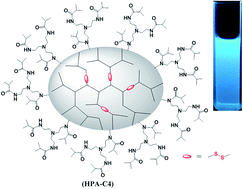Stimuli-responsive hyperbranched poly(amidoamine)s integrated with thermal and pH sensitivity, reducible degradability and intrinsic photoluminescence†
Abstract
A series of hyperbranched poly(amidoamine)s (HPAs) were synthesized from the Michael addition copolymerization of tris(2-aminoethyl) amine (TAEA) and two bisacrylamide monomers N,N′-cystamine bisacrylamide (CBA) and N,N′-hexamethylene bisacrylamide (HMBA) at room temperature. The further modification with isobutyric anhydride led to isobutyramide terminated HPA (HPA-C4). 1H NMR and 15N NMR characterizations proved the successful preparation of these polymers. Moreover, beside the contents of TAEA, CBA and HMBA units in the composition, 15N NMR spectrometry could supply more structural information than 1H NMR spectrometry, such as the ratio of different amine groups in polymers, the transformation efficiency of reactive primary and secondary amines into C4 groups. GPC measurements not only gave the information of molecular weight and polydispersity, but also proved that all the HPA-C4s containing disulfide bonds could be degraded after being treated with dithiothreitol (DTT). Turbidimetry measurements showed that HPA-C4s had thermoresponsive property in water. The cloud point temperature (Tcp) of HPA-C4s was pH-dependent. Moreover, DTT could only affect the thermoresponsive property of HPA-C4s containing disulfide bonds due to the induced polymer degradation. Although no traditional fluorophores existed in HPA-C4s, HPA-C4s could emit blue fluorescence centered at ca. 455 nm. The fluorescence intensity was influenced pronouncedly by polymer concentration, pH, oxidizing time.



 Please wait while we load your content...
Please wait while we load your content...